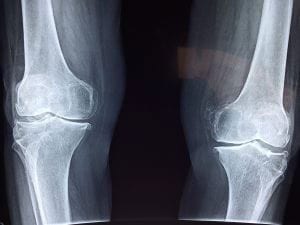Hereditary Multiple Osteochondromas (HMO)
What is hereditary multiple osteochondromas (HMO)?
Hereditary multiple osteochondromas (HMO) is a rare genetic disorder characterized by multiple noncancerous (benign) bone tumors that are covered by cartilage, called osteochondromas or exostoses. These often occur on the growing end of the long bones of the legs, arms, and digits or on the flat bones of the hip and shoulder blade and can lead to other complications in the bones and skeletal system. Hereditary multiple osteochondromas was formerly known as hereditary multiple exostoses.What causes hereditary multiple osteochondromas (HMO)?
HMO is caused by mutations in either the EXT1 gene or the EXT2 gene. It is thought that these genes play a role in tumor suppression in the body, and they are inherited in an autosomal dominant pattern.What are the symptoms of hereditary multiple osteochondromas (HMO)?
HMO is usually diagnosed in affected individuals by 12 years of age. Because these growths vary in size and number, the signs and symptoms of the disorder vary in severity, as well. If the exostoses are small, they may have little to no effect on the patient, but in more severe cases, the growths can cause deformities of the forearm, knees, ankles, spine, and/or pelvis. In turn, these deformities can impose on the nerves, tendons, and blood vessels, which interferes with movement or circulation and can cause substantial pain. Difficulty walking and general discomfort are also common. In addition to these complications, some affected individuals also have mild short stature from their shortened and/or bowed legs, spinal cord compression from numbness and/or paralysis, or urinary obstruction from exostoses of the pelvic area.How is hereditary multiple osteochondromas (HMO) diagnosed?
A diagnosis of HMO is based on an observation of the clinical features of the disease in an examination, along with a patient and family history. X-ray findings and molecular genetic testing of the EXT1 and EXT2 genes can confirm a diagnosis.What are the available treatments for hereditary multiple osteochondromas (HMO)?
Surgery is extremely beneficial in HMO cases to relieve pain, improve management, restore normal circulation, or for cosmetic reasons. If tumors turn malignant, this degeneration can be also treated surgically, possibly in combination with chemotherapy and radiation therapy. These malignancies have a 1 in 20 to 1 in 200 risk of occurring.Where can I find more about hereditary multiple osteochondromas (HMO)?
Hereditary Multiple Osteochondromas (HMO) Articles

A Journey to Self-Empowerment: What Kandise Has Learned from Life with Hereditary Multiple Exostoses (HME) (Pt. 2)
Jessica Lynn
February 28, 2023
Read More »

A Journey to Self-Empowerment: What Kandise Has Learned from Life with Hereditary Multiple Exostoses (HME) (Pt. 1)
Jessica Lynn
February 24, 2023
Read More »

One Fibrodysplasia Ossificans Progressiva Trial is on Hold but Another has Shown Promise
Trudy Horsting
February 4, 2020
Read More »

New Resources Could Improve Drug Development for Fibrodysplasia Ossificans Progressiva
Trudy Horsting
March 4, 2019
Read More »




